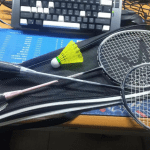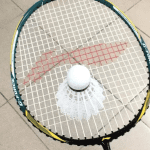
Badminton Racket Lining WOODS N90 III Reviews
One of my colleagues in the office, who has a lot of experience, used to try out all the top rackets used by national team players during their time with the Red Factory. He often complained to me about various issues with the series, especially regarding the shaft.
I haven’t experienced it myself, so I can only agree based on word-of-mouth, though it hasn’t stopped several colleagues in my office from buying this model. It seems to have a pretty large user base.
This is a powerful racket, but it’s not the successor to the N902; it actually inherits from the N80, so don’t get confused.

Specifications: 3UG5, stripped of its base, total weight in used condition 96.2g, balance point 310mm, shaft length 220mm, medium to high stiffness, wind-breaking frame, 76-hole string bed, 8-4 o’clock string groove, warranty 30 lbs, strung at 25-27 lbs with AB string.
Among the old Li-Ning rackets, this model is highly recognizable and very attractive, which is likely why many players are willing to buy it. The pure white base paint extends to the inside of the wind-breaking frame as well. The shaft is very robust, and the frame is similarly sturdy, giving it a powerful appearance, with several Dan symbols and cross marks on the frame that make the 903 look like a fully armored knight. The frame has many familiar technological markers that were continued in later Wind Blade series.

Firstly, the head-heavy feel of the racket is very pronounced. With this high swing-speed frame type, it’s challenging for me to control the rhythm during initial adjustment stages, and I often hit the frame in active shots. However, the sweet spot is quite large. The feedback from hitting feels very much like the Wind Blade series, somewhat similar to the Jian Jian and Sharp Peak models I’ve been using recently, with a wooden and bouncy feel.
The continuity in mid-court and front-court play is significantly affected. Although the 903 delivers powerful shots and can easily create openings in the opponent’s returns, it becomes frustrating when you can’t reach high points after following up.

Old Li-Ning rackets with such thick shafts may not have the best elasticity by today’s standards, but they offer exceptional anti-twist performance. The racket has good directional control and a large hitting area, making it highly responsive and precise. I find it hard to resist the urge to use the 903 for powerful smashes—not just soft presses, point attacks, or broader offensive plays, but for full-body power smashes. The 903 has a strong hammer-like feel; it’s like a child finding a handy stick by the roadside and wanting to swing it. The strong down-force sensation makes the hitting moment feel electrifying, and the shot quality matches this intense power, making the shuttle feel like a cannonball.
Despite its solid feel and excellent net control, it’s quite difficult for receiving smashes. In doubles, you need to stand further back compared to using other rackets to achieve better defensive performance due to the extended pre-swing caused by the racket’s weight.

The racket naturally encourages more power usage in all types of shots—flat drives, clears, defensive responses, and smashes. It tends to make players exert more force. To be honest, its difficulty in use is more dependent on the user’s physical fitness. I suddenly remember that the owners of the 903 in my office are all quite robust.
So, if the N80 is the big brother of the Wind Blade series, then the N903 is definitely the second brother. Considering it’s an upgraded version of the Wind Blade 500, those who like the powerful performance and have a fondness for Lin Dan’s endorsed products might want to give it a try.










